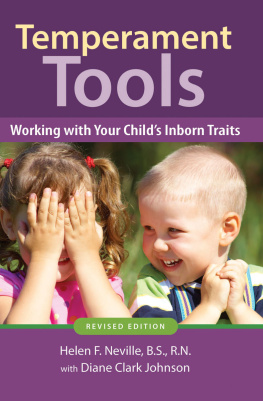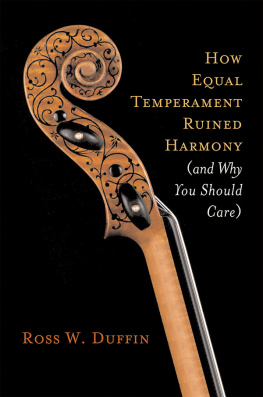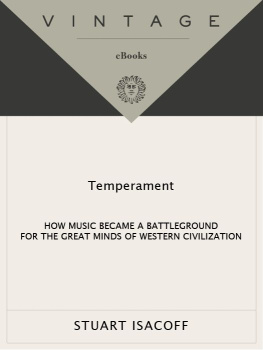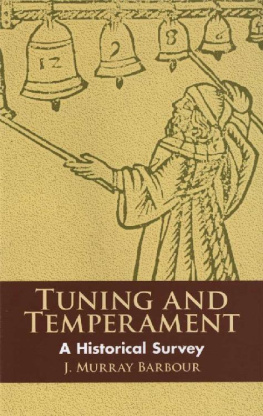Cover
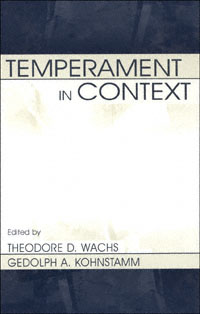
| title | : | Temperament in Context |
| author | : | Wachs, Theodore D.; Kohnstamm, Geldolph A. |
| publisher | : | Lawrence Erlbaum Associates, Inc. |
| isbn10 | asin | : | 0805830197 |
| print isbn13 | : | 9780805830194 |
| ebook isbn13 | : | 9780585376547 |
| language | : | English |
| subject | Temperament--Congresses, Temperament in children--Congresses. |
| publication date | : | 2001 |
| lcc | : | BF798.T443 2001eb |
| ddc | : | 155.2/6 |
| subject | : | Temperament--Congresses, Temperament in children--Congresses. |
Page i
This page intentionally left blank
Page ii
This page intentionally left blank
Page iii
Temperament in Context

Edited by
Theodore D. Wachs
Purdue University
Gedolph A. Kohnstamm
University of Leiden

Page iv
Copyright 2001 by Lawrence Erlbaum Associates, Inc.
All rights reserved. No part of this book may be repro
duced in any form, by photostat, microfilm, retrieval sys
tem, or any other means, without prior written
permission of the publisher.
Lawrence Erlbaum Associates, Inc., Publishers
10 Industrial Avenue
Mahwah, NJ 07430
Cover design by Kathryn Houghtaling Lacey |
Library of Congress Cataloging-in-Publication Data
Temperament in Context / edited by Theodore D. Wachs,
Gedolph A. Kohnstamm.
p. cm.
Includes bibliographical references and index.
ISBN 0-8058-3019-7 (hardcover)
1. TemperamentCongresses. 2. Temperament in children
Congresses. I. Wachs, Theodore D., 1941
II. Kohnstamm, Gedolph A., 1937
BF798.T443 2001
155.2'6dc21
00-057285
CIP
Books published by Lawrence Erlbaum Associates are
printed on acid-free paper, and their bindings are chosen for
strength and durability.
Printed in the United States of America
10 9 8 7 6 5 4 3 2 1
Page v
Contents
Introduction Theodore D. Wachs and Gedolph A. Kohnstamm | vii |
Chapter 1
A Theoretical Context for Adult Temperament Paul T. Costa, Jr. and Robert R. McCrae | |
Chapter 2
Temperament, Stress, and Soothing Douglas Ramsay and Michael Lewis | |
Chapter 3
Inhibited and Uninhibited Children: Biology in the Social Context Doreen Arcus | |
Chapter 4
Temperamental Change, Parenting, and the Family Context Charles F. Halverson and James E. Deal | |
Chapter 5
Temperament and Context: Correlates of Home Environment With Temperament Continuity and Change, Newborn to 30 Months Adam P. Matheny, Jr., and Kay Phillips | |
Chapter 6
Temperament and Socioemotional Adjustment to Kindergarten: A Multi-Informant Perspective H. Hill Goldsmith, Nazan Aksan, Marilyn Essex, Nancy A. Smider, and Deborah Lowe Vandell | |
Page vi
Chapter 7
Culture as a Context for Temperament: Suggestions From the Life Courses of Shy Swedes and Americans Margaret Kerr | |
Chapter 8
The Role of Temperament as a Moderator of Stress Jan Strelau | |
Chapter 9
Adjustment Style in Childhood as a Product of Parenting and Temperament John E. Bates | |
Chapter 10
The Bidirectional Nature of TemperamentContext Links Theodore D. Wachs and Gedolph A. Kohnstamm | |
Author Index | |
Subject Index | |
Page vii
Introduction
Temperament is traditionally defined as relatively stable, early appearing, biologically based individual traits (Rothbart & Bates, 1998). Individual differences in temperament along such dimensions as reactivity and self-regulation are viewed as an essential first step to individual variability in later personality patterns. Individual differences in temperament are thought to be related to individual genetic differences (Goldsmith, 1989; Plomin & Saudino, 1994), which in turn lead to individual differences in those aspects of central nervous system structure and neurochemistry that act to mediate individual differences in temperament (Calkins & Fox, 1994; Kagan, Reznick, & Snidman, 1989; Strelau, 1994).
Although an emphasis on the biological roots of temperament can be traced back to the early centuries of the present millennium (Diamond, 1974), historically there has also been speculation on the role played by nonbiological contextual influences such as climate and education (Jacques, 1881). For the purposes of this volume we define context as "organized conditions or patterns of external stimuli that impinge upon and have the probability of influencing the individual" (Wachs, 1992, p. 39). It is important to recognize that this broad definition of context can encompass both psychosocial (e.g., the family, culture) and biological conditions (e.g., physical ecology, diet, environmental toxins). The focus of this volume is primarily on the psychosocial context, given that there is only limited evidence available on the behavioral consequences associated with variability in the biological context. Summarization of evidence on issues involving the measurement of the biological context in behavioral research can be found in a recent chapter by Evans (1999); summarization of evidence on diet and temperament can be found in a chapter by Wachs (in press).
The relative neglect of psychosocial contributions to the study of temperament in part reflects the historical tradition of viewing temperament as a biologically rooted phenomena. In addition, as pointed out by Matheny and Phillips (chap. 6, this volume), the longstanding assumption that temperament is a highly stable phenomena hindered the search for psychosocial contextual variables that might lead to discontinuity in temperament over time or across situations. However, as pointed out by other contributors to this
Page viii
volume (e.g., Arcus, chap. 4) the modest level of predictability of temperament variability from purely biological predictors, as well as the modest level of predictability of developmental outcomes from temperament per se, has emphasized the need to go beyond main effect theories concerning temperament and development. Even among temperament theorists who have a strong biological orientation there is nonetheless agreement that temperament is more than just a biological phenomena (Buss & Plomin, 1984; Rothbart, 1989). Conceptually, the importance of linking temperament to psychosocial context has been most often emphasized in the writings of Chess and Thomas (1991, 1999), with specific reference to the concept of "goodness of fit." As defined by Thomas and Chess (1977): "Goodness of fit results when the properties of the environment and its expectations and demands are in accordance with the organism's own capacities, characteristics and style of behaving" (pp. 1112). When there is a good fit the individual is able to adapt and function effectively in his or her environment; under conditions of poor fit ("discrepancies and dissonances between environmental opportunities and demands and the capacities of the organism," Thomas & Chess, 1977, pp. 1112) maladjustment and deviations from normal developmental trajectories are more likely to occur. The critical point is that development is a function of neither the individual's environment nor of their temperament but rather of the nature of the interaction (fit) between individual and environmental characteristics.
Next page

